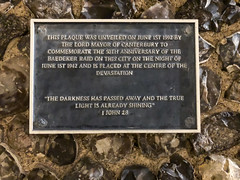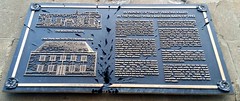Baedeker Blitz
(1942)
thing and bombing
Died aged 0
Wikidata WikipediaThe Baedeker Blitz or Baedeker raids were a series of aerial attacks in April and May 1942 by the German Luftwaffe on English cities during the Second World War. The name derives from Baedeker, a series of German tourist guide books, including detailed maps, which were used to select targets for bombing. The raids were planned in response to a devastating increase in the effectiveness of the Royal Air Force's (RAF) bombing offensive on civilian targets after the Area Bombing Directive (General Directive No.5 (S.46368/111. D.C.A.S), starting with the bombing of Lübeck in March 1942. The aim was to begin a tit-for-tat exchange with the hope of forcing the RAF to reduce their attacks. To increase the effect on civilian morale, targets were chosen for their cultural and historical significance, rather than for any military value. The majority of the raids took place in late April 1942 through May 1942, but towns and cities continued to be targeted for their cultural value over the following two years. By any measure, the attempt was a failure. In the time following the original German bombing campaign of 1940–41 ("The Blitz"), a little over a year earlier, the RAF had dramatically improved its night fighter capability and introduced the AMES Type 7 radar specifically for the night fighting role. Losses to the Luftwaffe's bomber force were unsustainable, and for a variety of reasons the damage to the targeted cities was minimal compared to the Blitz or to the contemporaneous RAF bombing campaign against Germany. Nevertheless, the raids resulted in over 1,600 civilian deaths and tens of thousands of damaged homes.
DbPedia
Commemorated on 2 plaques
This plaque was unveiled on June 1st 1992 by the Lord Mayor of Canterbury to commemorate the 50th anniversary of the Baedeker Raid on this city on the night of June 1st 1942 and is placed at the centre of the devastation "The darkness has passed away and the true light is already shining" 1 John 28
St George's Street, Canterbury, United Kingdom where it sited (1942)
In memory of the 417 persons killed in the World War II Baedeker Raids of 1942. [full inscription unknown]
James Street West, Bath, United Kingdom where it sited

